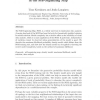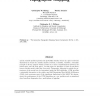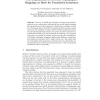181 search results - page 1 / 37 » On the generative probability density model in the self-orga... |
IJON
2002
13 years 4 months ago
2002
The Self-Organizing Map, SOM, is a widely used tool in exploratory data analysis. A major drawback of the SOM has been the lack of a theoretically justified criterion for model se...
NECO
1998
13 years 4 months ago
1998
Latent variable models represent the probability density of data in a space of several dimensions in terms of a smaller number of latent, or hidden, variables. A familiar example ...
BMCBI
2004
13 years 4 months ago
2004
Background: Many current gene prediction methods use only one model to represent proteincoding regions in a genome, and so are less likely to predict the location of genes that ha...
ICANN
2010
Springer
13 years 5 months ago
2010
Springer
One way to handle the perception of images that change in position (or size, orientation or deformation) is to invoke rapidly changing fiber projections to project images into a fi...
EELC
2006
13 years 8 months ago
2006
We present a neural-competitive learning model of language evolution in which several symbol sequences compete to signify a given propositional meaning. Both symbol sequences and p...



